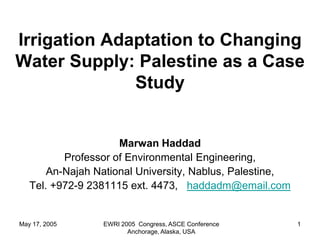Irrigation Adaptation to Changing Water Supply
- 1. May 17, 2005 EWRI 2005 Congress, ASCE Conference Anchorage, Alaska, USA 1 Irrigation Adaptation to Changing Water Supply: Palestine as a Case Study Marwan Haddad Professor of Environmental Engineering, An-Najah National University, Nablus, Palestine, Tel. +972-9 2381115 ext. 4473, haddadm@email.com
- 2. May 17, 2005 EWRI 2005 Congress, ASCE Conference Anchorage, Alaska, USA 2 Study Area: Palestine • Palestine as presented in this paper consists of the West Bank and the Gaza Strip • The West Bank and the Gaza Strip are those parts of Historic Palestine which were occupied by the Israeli army during the 1967 war between Israel and Egypt, Syria, and Jordan
- 3. May 17, 2005 EWRI 2005 Congress, ASCE Conference Anchorage, Alaska, USA 3
- 4. May 17, 2005 EWRI 2005 Congress, ASCE Conference Anchorage, Alaska, USA 4 • Population : Palestinian population projections reveal that mid year population in 2003 totaled 3,634,495 persons, of whom 2,304,825 in the West Bank and 1,329,670 in Gaza Strip
- 5. May 17, 2005 EWRI 2005 Congress, ASCE Conference Anchorage, Alaska, USA 5 There are 686 localities in Palestine. The localities are distributed by type as • 54 urban, • 603 rural, and • 29 refugee camps. These localities distributed by type of authority as • 107 municipalities, • 11 local councils, • 374 village council or project committee, and • 29 director of refugee camp (additional 76 rural localities are either not inhibited or joined to larger locality).
- 6. May 17, 2005 EWRI 2005 Congress, ASCE Conference Anchorage, Alaska, USA 6 Available Water resources : • Average annual ground water recharge in Palestine is 698 to 708 mcm/yr (648 mcm/yr in the West Bank and 50 - 60 mcm/yr in the Gaza Strip). • The only surface water source in the West Bank is the Jordan river and its tributaries. The Palestinian share in the Jordan River of 241 mcm/yr. • Since 1967 war and until present, Palestinians were prohibited by the Israeli army from using the Jordan river water and their lands and farms located along the western side of the river were confiscated and the area was declared as a restricted military security zone.
- 7. May 17, 2005 EWRI 2005 Congress, ASCE Conference Anchorage, Alaska, USA 7 The Wall • Israel's decided to establish a permanent barrier between the West Bank and Israel in April 2002. • The construction of the wall subjected Palestinians to several water vulnerabilities, including irrigation infrastructure devastation, impeded access and mobility to water and irrigation land resources, increased land aridity, and detrimental effects on community socio- economic and migration.
- 8. May 17, 2005 EWRI 2005 Congress, ASCE Conference Anchorage, Alaska, USA 8 The Wall • Despite the fact that the expansion and annexation wall is not yet completed and it is too early to observe many of the social implications of it, • and the fact that some of the effects will take time to become manifest as migration, the households will first have to learn how it is to live with the new situation caused by the wall, and then find coping mechanisms
- 9. May 17, 2005 EWRI 2005 Congress, ASCE Conference Anchorage, Alaska, USA 9 The Wall • The Wall is not just a barrier. It consists of a whole regime, composed of a complex physical structure as well as practical, administrative and other measures. It is being constructed almost entirely in the Palestinian Occupied Territory - OPT, including in and around East Jerusalem, in departure from the Green Line
- 10. May 17, 2005 EWRI 2005 Congress, ASCE Conference Anchorage, Alaska, USA 10
- 11. May 17, 2005 EWRI 2005 Congress, ASCE Conference Anchorage, Alaska, USA 11 • It encircles entire Palestinian communities, including Qalqiliya, a city of 41,000 inhabitants, in walled, Bantustan-like enclaves, • The total length of the Wall once completed is estimated to be 788 kilometers. The Wall will be constructed in several phases. The majority of the Wall complex, consisting of multiple components, varies in width between 30 and 100 meters and up to 8 meters in height
- 12. May 17, 2005 EWRI 2005 Congress, ASCE Conference Anchorage, Alaska, USA 12
- 13. May 17, 2005 EWRI 2005 Congress, ASCE Conference Anchorage, Alaska, USA 13
- 14. May 17, 2005 EWRI 2005 Congress, ASCE Conference Anchorage, Alaska, USA 14
- 15. May 17, 2005 EWRI 2005 Congress, ASCE Conference Anchorage, Alaska, USA 15
- 16. May 17, 2005 EWRI 2005 Congress, ASCE Conference Anchorage, Alaska, USA 16
- 17. May 17, 2005 EWRI 2005 Congress, ASCE Conference Anchorage, Alaska, USA 17
- 18. May 17, 2005 EWRI 2005 Congress, ASCE Conference Anchorage, Alaska, USA 18
- 19. May 17, 2005 EWRI 2005 Congress, ASCE Conference Anchorage, Alaska, USA 19
- 20. May 17, 2005 EWRI 2005 Congress, ASCE Conference Anchorage, Alaska, USA 20
- 21. May 17, 2005 EWRI 2005 Congress, ASCE Conference Anchorage, Alaska, USA 21
- 22. May 17, 2005 EWRI 2005 Congress, ASCE Conference Anchorage, Alaska, USA 22
- 23. May 17, 2005 EWRI 2005 Congress, ASCE Conference Anchorage, Alaska, USA 23
- 24. May 17, 2005 EWRI 2005 Congress, ASCE Conference Anchorage, Alaska, USA 24 Can Separation Walls Make Bad Neighbors ?
- 25. May 17, 2005 EWRI 2005 Congress, ASCE Conference Anchorage, Alaska, USA 25
- 26. May 17, 2005 EWRI 2005 Congress, ASCE Conference Anchorage, Alaska, USA 26
- 27. May 17, 2005 EWRI 2005 Congress, ASCE Conference Anchorage, Alaska, USA 27
- 28. May 17, 2005 EWRI 2005 Congress, ASCE Conference Anchorage, Alaska, USA 28




























